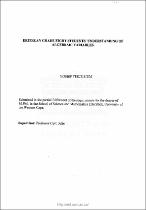| dc.contributor.advisor | Julie, Cyril | |
| dc.contributor.author | Yosief, Tekie Sium | |
| dc.date.accessioned | 2023-06-13T12:29:14Z | |
| dc.date.available | 2023-06-13T12:29:14Z | |
| dc.date.issued | 2003 | |
| dc.identifier.uri | http://hdl.handle.net/11394/10217 | |
| dc.description | Magister Philosophiae - MPhil | en_US |
| dc.description.abstract | This study investigated Eritrean grade eight students' understanding of algebraic variables. A complete count survey of all secondary schools of one province was done and the one that took part in the study was Gash-Barka province. The study adopted the test and framework developed by Kuchemann (1980). Children's responses and the items themselves were classified into "levels of understanding". Items of the test were classified into four levels based on the name that can be given to letters in solving a problem and the structural complexity of the item. These items were used to classify the Eritean grade eight students' performances into five "levels of
understanding".The present study produced results that showed that 72.6 % of the students dealt with letters in algebraic expressions and equations as objects. Whilst 3.7 % of the students were able to regard letters as specific unknowns, only 0.2 Yo of the students were able to
consider letters as generalized numbers or variables. That is, almost all (95.9 %) of the tested Eritrean grade eight students were unable to cope consistently with items that can properly be called algebra, that is, items where the use of letters as unknown numbers
cannot be avoided. Comparisons by school and gender were done to see if there were relationships among the levels of understanding and the two variables. The findings showed that there was no significant relationship among the levels of understanding and gender of the students. However, the comparison by school showed that there was significant relationship between schools and levels of understanding. The Pearson chi-square test showed that the relationship between the level of understanding and gender was not significant, whereas
the relationship between levels of understanding and school was statistically significant at 0.05 level of significance. | en_US |
| dc.language.iso | en | en_US |
| dc.publisher | University of the Western Cape | en_US |
| dc.subject | Eritrea | en_US |
| dc.subject | Secondary school | en_US |
| dc.subject | Students | en_US |
| dc.subject | Mathematics education | en_US |
| dc.subject | Algebra | en_US |
| dc.subject | Variables | en_US |
| dc.subject | Concepts | en_US |
| dc.subject | Understanding | en_US |
| dc.subject | Students misconceptions | en_US |
| dc.title | Eritrean grade eight student understanding of algebraic variables | en_US |
| dc.rights.holder | University of the Western Cape | en_US |

